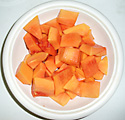Papaya fruit nutrition facts
Exotic papaya fruit or pawpaw is packed with numerous health benefiting nutrients. The fruit is one of the favorite of fruit lovers for its nutritional, digestive, and medicinal properties. Papaya tree is grown extensively all over the tropical regions and cultivated for its fruits and latex papain, an enzyme that is used in food industry.
Botanically, the plant belongs to the family of Caricaceae of genus; Carica and scientifically named as Carica papaya.
Papaya tree bears many spherical or pear-shaped fruits that can have about 6-20 inches in length and 4-12 inches in diameter. The average sized papaya weighs about a pound. The fruit is said to ripen when it feels soft to thumb pressure and its skin has attained an amber to orange hue.
Inside, the fruit features numerous black seeds, encased in a mucin coat, in the hollow central cavity. The flesh is orange in color with either yellow or pink hues, soft in consistency and has deliciously sweet, musky taste with rich flavor.
Babaco fruit is closely related to papaya, has similar appearance and flavor as papaya.
Papaya fruit health benefits
-
The fruit is very low in
calories (just 39 cal/100 g) and contains no
cholesterol; but is a rich source of phyto-nutrients, minerals, and
vitamins.
-
Papayas contain soft,
easily
digestible pulp/flesh with good amount of soluble dietary fiber that
helps to have normal bowel movements; thereby reducing constipation.
-
Fresh, ripe
fruit is one of
the fruit with highest
vitamin-C content (provides about 103% of
DRA, more than in oranges,
or lemons). Research
studies have shown
that vitamin C has many important functions like free radicals
scavenging, immune booster, and anti-inflammatory actions.
-
It is also an excellent
source
of Vitamin-A (provides
1094 IU/100 g) and flavonoids like beta
carotenes, lutein, zeaxanthin and cryptoxanthins. Vitamin A is also
required for maintaining healthy mucus membranes and skin and is
essential for vision. These compounds are known to have antioxidant
properties; help act as protective scavengers against oxygen-derived
free radicals and reactive oxygen species (ROS) that play role in aging
and various disease processes. Consumption of natural fruits rich in
carotenes has known to protect body from lung and oral cavity cancers.
-
Papaya fruit is also rich
in
many essential B-complex vitamins such as Folic acid, pyridoxine
(vitamin B-6), riboflavin, and thiamin (vitamin B-1). These vitamins
are essential in the sense that body requires them from external
sources to replenish and play vital role in metabolism.
-
Fresh papaya also contains
good amount of potassium (257 mg per 100 g) and calcium. Potassium is
an important component of cell and body fluids and helps controlling
heart rate and blood pressure countering effects of sodium.
-
Papaya has been proven natural remedy
for many ailments. In traditional medicine,
papaya seeds are anti-inflammatory, anti-parasitic, and analgesic, and
they are used to treat stomachache and ringworm infections.
Selection and storage
Papaya is usually harvested when it shows signs of maturity; evident as skin slightly turning to yellow. Organic papayas usually left to ripen on the tree, however, care should be taken since over-ripen fruits actually falls off themselves and spoiled.In the store, papayas come with various sizes and maturity; therefore, select the one based on the serving size and timing. Choose the one with intact skin without any bruises or cuts. Unripe fruits can be kept at room temperature for few days but ripen ones should be stored in the refrigerator. Bring back the fruit to normal temperature when it is to be eaten to get their natural taste and flavor.nripe green papaya is cooked as vegetable in many Asian and Pacific regions. However, the fruit should not be eaten raw as it contains toxic alkaloids in its milky latex.
Preparation and serving method
Wash papaya fruit thoroughly in cold running water to remove dust and any pesticide residues. Skin is bitter in taste and inedible. Remove skin with "peeling knife", cut the fruit longitudinally in to two equal halves. Gently remove seeds and thin slimy layer loosely adhering to the flesh. Cut the fruit longitudinally like melon or cut into small cubes.Here are some serving tips:
-
Ripe papaya fruit is usually
eaten raw with a twist of lemon drops.
-
Fresh papaya cubes are a great
addition to fruit salads.
-
Papaya juice with ice cubes is
a popular drink.
-
Its cubes are used in ice creams, shakes,
sorbets, salsa etc.
-
Ripe fruit also goes well with chicken and
seafood savory dishes.
-
Unripe green papaya can be used as vegetable, either cooked, usually in stews, stir-fry, curries, and soups.

No comments:
Post a Comment